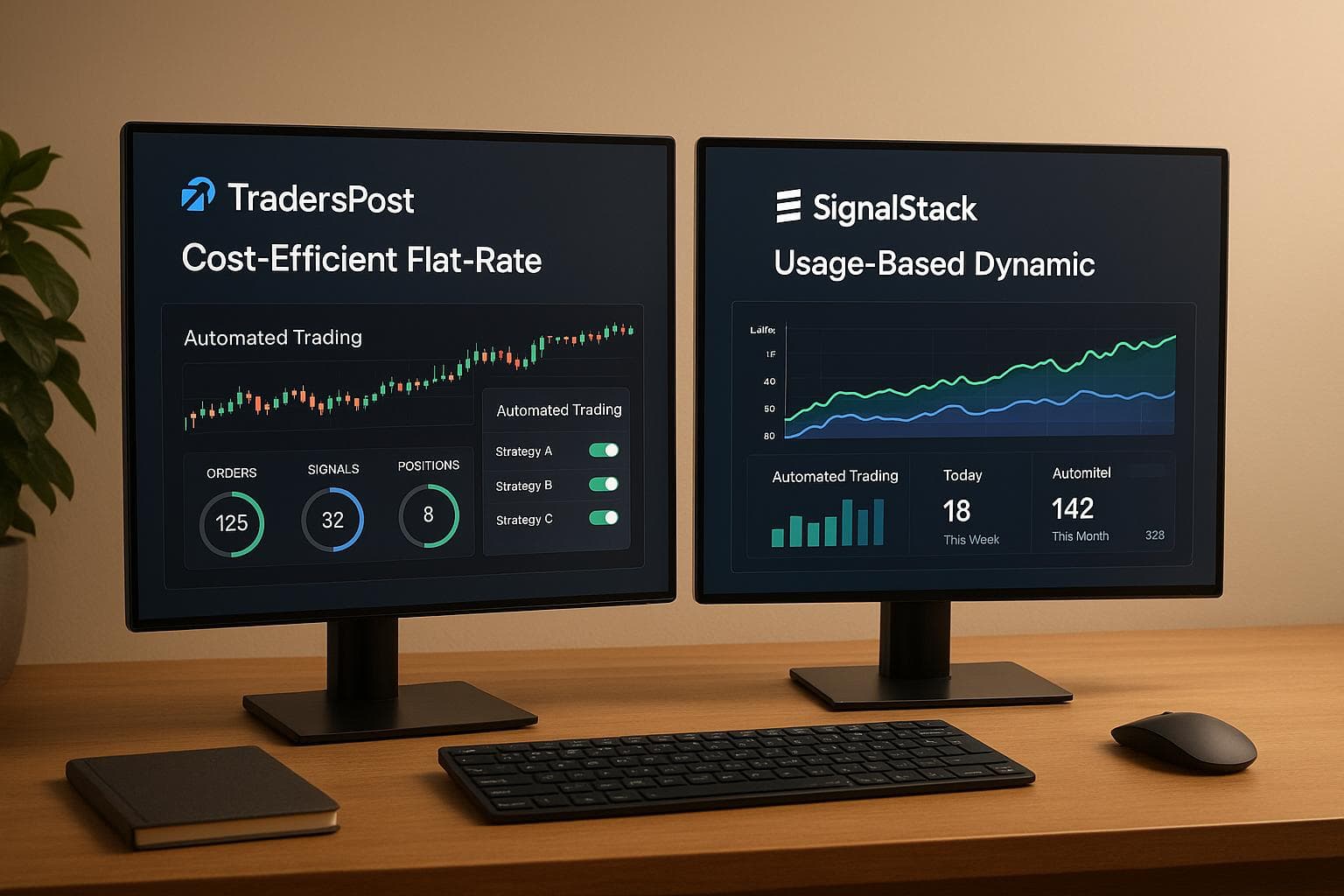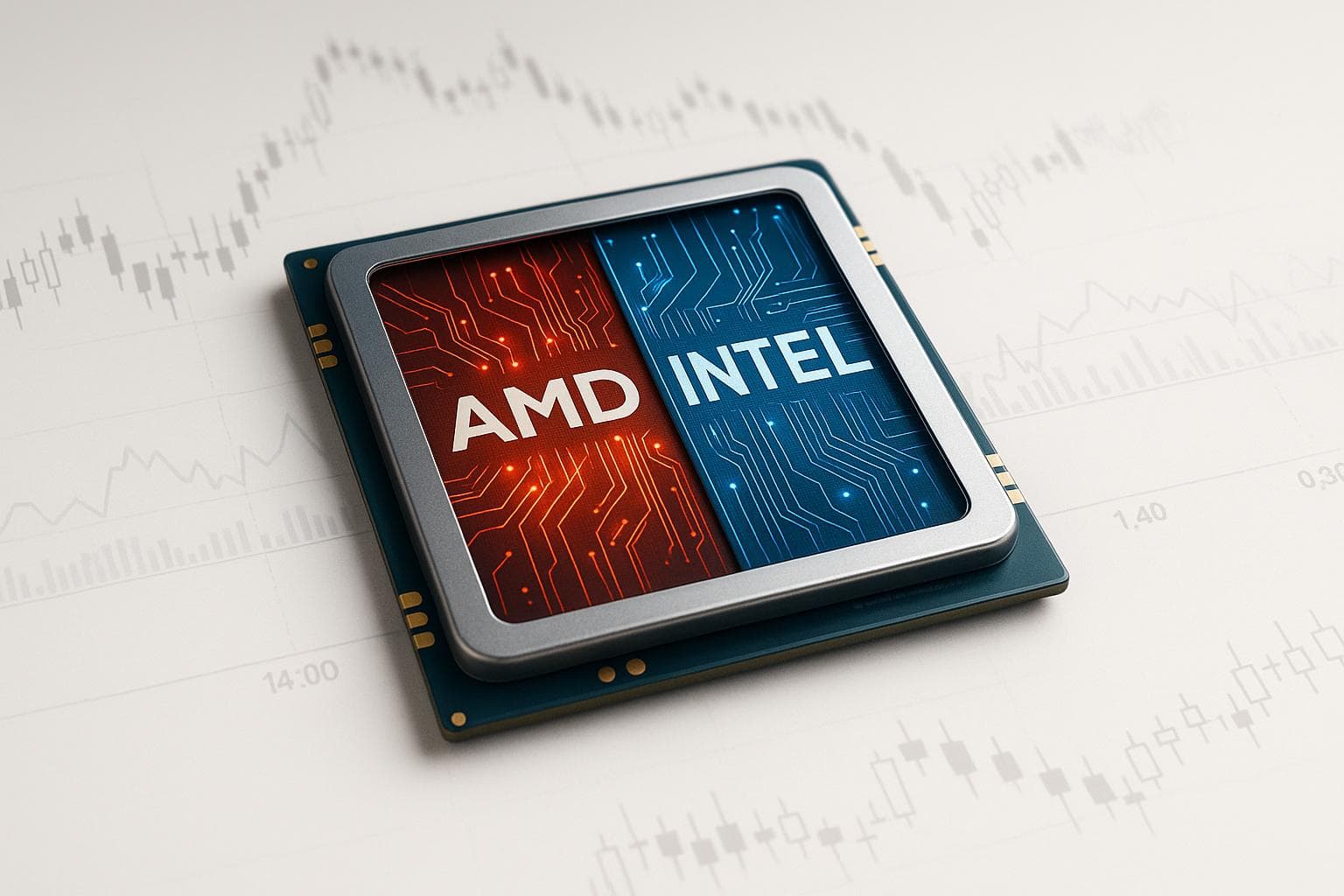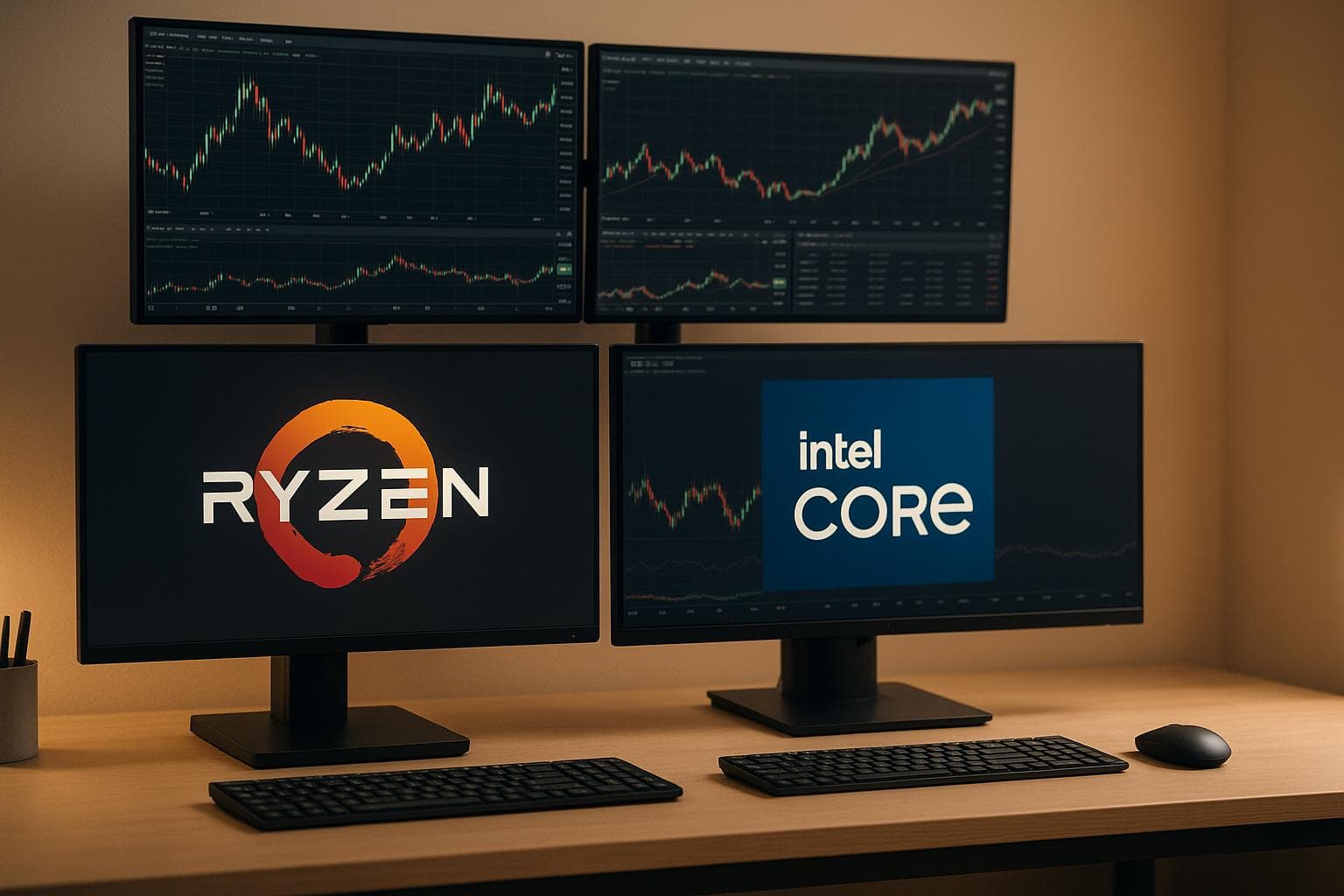Volume analysis tools are essential for traders in 2025, offering real-time insights into market trends and order flow. If you’re looking for alternatives to Bookmap, here are five platforms that stand out:
- TrendSpider: Known for its Volume-by-Price indicator and innovative Raindrop Charts, it combines volume data with price trends for deeper analysis. Pricing starts at $52/month.
- NinjaTrader: Offers advanced order flow tools like volumetric bars and market depth visualization. Free for basic charting; advanced features start at $59/month.
- Sierra Chart: Focused on footprint charting and Depth of Market (DOM) analysis, it’s highly customizable. Pricing is available upon request.
- Jigsaw Trading: Features tools like Auction Vista and Reconstructed Tape for precise order flow analysis. One-time licenses start at $579.
- Quantower: A multi-asset platform with Cluster Charts and DOM Surface for detailed volume analysis. Plans start at $40/month.
These platforms cater to different trading needs, from beginners to professionals. Below is a quick comparison to help you decide.
Quick Comparison
| Platform | Key Features | Pricing | Best For |
|---|---|---|---|
| TrendSpider | Volume-by-Price, Raindrop Charts | $52–$273/month | Swing traders, technical analysis |
| NinjaTrader | Volumetric bars, market depth | Free–$59/month | Futures, beginners |
| Sierra Chart | Footprint charts, DOM analysis | On request | Advanced customization |
| Jigsaw Trading | Auction Vista, Reconstructed Tape | $579–$1,979 | Professional order flow traders |
| Quantower | Cluster Charts, multi-asset support | $40–$70/month | Multi-asset, crypto traders |
Each tool has unique strengths, so choose based on your trading style and hardware setup. For smooth performance, ensure your system meets hardware recommendations, such as 16–32 GB RAM and SSD storage.
Best Orderflow Tools & Platforms In 2023 (Bookmap & Sierra Charts)
1. TrendSpider
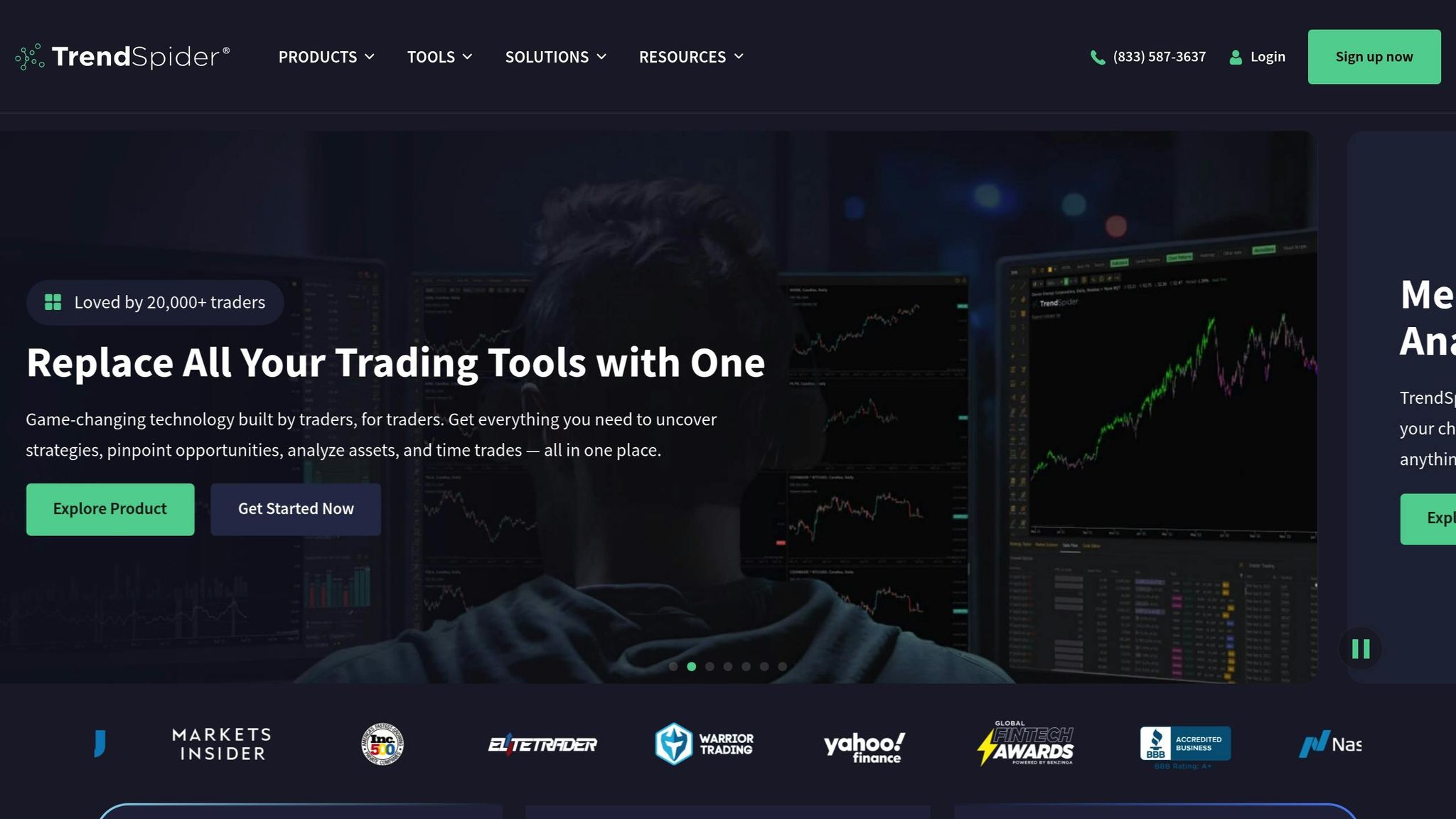
TrendSpider is a cloud-based platform that brings advanced volume analysis straight to your web browser, making it accessible on virtually any device.
Volume Analysis Features
At the heart of TrendSpider’s volume analysis tools is the Volume-by-Price (VBP) indicator. This feature merges price and volume data to pinpoint key trading levels, such as the Point of Control (POC), Volume Weighted Average Price (VWAP), and Value Area calculations. For added clarity, its Pyramid Mode breaks down buying volume (shown with green candles) and selling volume (red candles), giving you a clear snapshot of market sentiment.
One standout feature is Raindrop Charts, which visualize volume distribution within individual price bars. This lets you see exactly where trading activity happened during different parts of a session, offering a deeper understanding of market dynamics.
TrendSpider also comes packed with over 200 built-in indicators, like On-Balance Volume (OBV), Chaikin Money Flow, and Klinger Oscillator. If you need something custom, you can create your own indicators using JavaScript or the AI Coding Assistant. The platform even integrates alternative data sources, including unusual options flow, dark pool trading data, FINRA Reg SHO data, and NASDAQ retail trading activity, giving users a more comprehensive view of market trends.
Hardware Compatibility
TrendSpider is designed to run smoothly on any device with a web browser, whether you’re using a desktop, laptop, or mobile device. For added convenience, there are native apps available for both iOS and Android, ensuring compatibility with all major operating systems.
Supported Trading Platforms
With integrations for over 30 brokerages and cryptocurrency exchanges, TrendSpider makes trading straightforward. Supported brokers include big names like Interactive Brokers, Charles Schwab, E*Trade, and several crypto exchanges. You can execute trades directly through the Trading widget, which connects to your broker via a free SignalStack account.
Pricing
TrendSpider offers several subscription plans, all of which come with a 14-day trial:
- Standard Plan: $52–$82/month
- Premium Plan: $62–$116/month
- Enhanced Plan: $83–$156/month
- Advanced Plan: $146–$273/month
- Business Plan: Starting at $399/month
For those opting for annual subscriptions, you can save up to 32% on your first invoice. Additional data feeds are available, including real-time futures data for $7.50 per month and professional US equities data for $29 per month.
"One of the key strengths of TrendSpider is its backtesting feature." – Shubham Bansal, Verified User
"One of the biggest pros of using TrendSpider is the automated charting." – Gufran Khan, Verified User
2. NinjaTrader
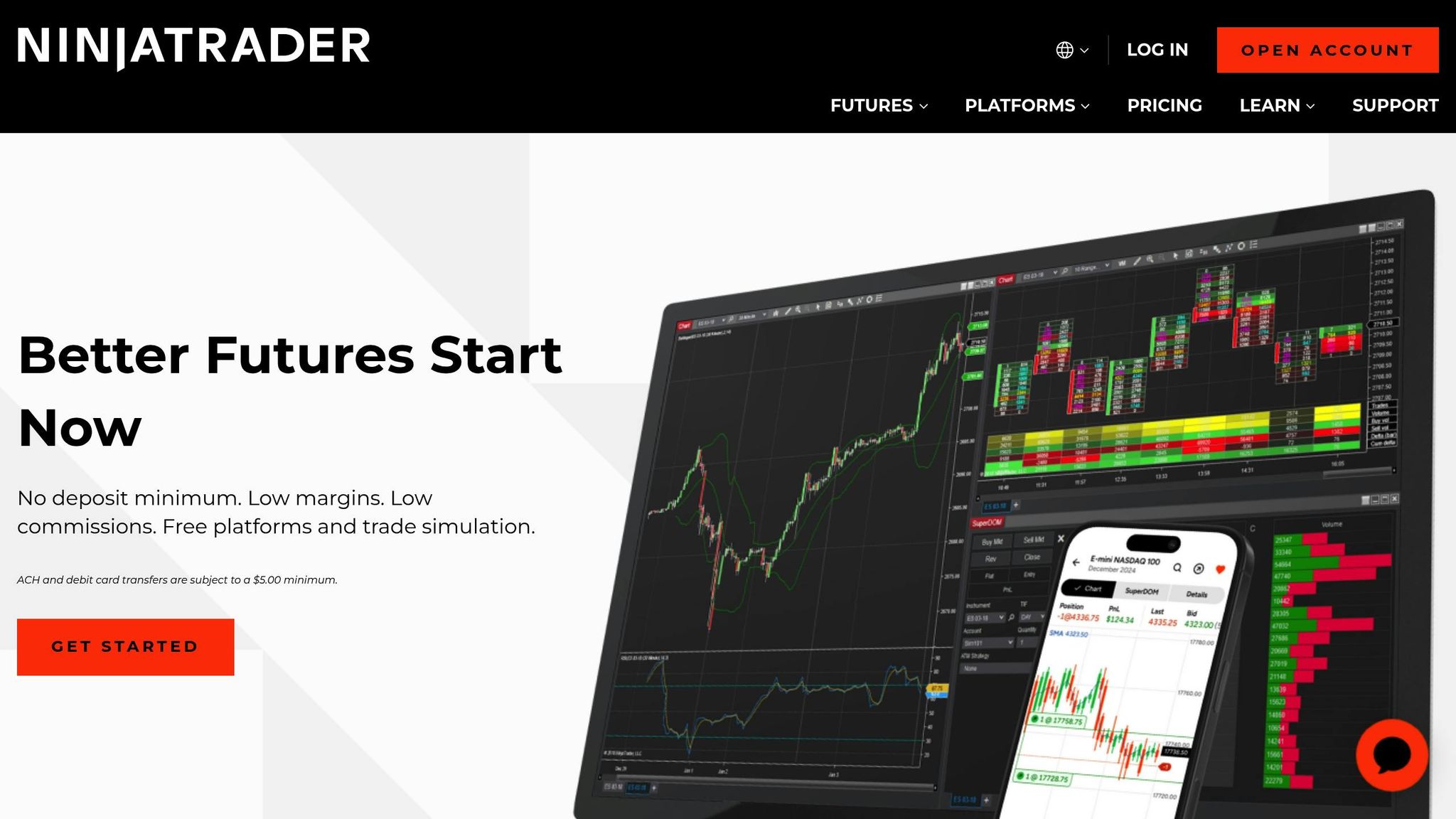
NinjaTrader is a robust trading platform that blends powerful volume analysis tools with professional-grade order flow visualization. It’s a go-to choice for traders looking to gain deeper insights into market behavior.
Volume Analysis Features
NinjaTrader offers a range of tools for volume analysis, starting with the Standard Volume Study. This feature displays volume as a histogram beneath price charts, helping traders confirm trends or spot potential market weakness. The platform’s Volume Profile tool takes it a step further, showing the number of contracts traded at various price levels. It also highlights the Point of Control (the price with the highest trading activity) and the Value Area, where 68–70% of trades occur. For those seeking more nuanced insights, the Volume-Weighted Average Price (VWAP) indicator is available. This tool plots multiple standard deviation bands around the VWAP, providing clues for support, resistance, and overbought or oversold conditions. These features set the stage for NinjaTrader’s advanced order flow tools.
Real-Time Order Flow Visualization
The Order Flow+ feature suite dives into granular market details. It includes volumetric bars with footprint-style visuals, revealing tick-by-tick buyer and seller activity, order imbalances, and volume clusters. The Order Flow Market Depth Map offers both historical and real-time views of the limit order book, while the Order Flow Trade Detector pinpoints significant trade events based on buyer or seller dominance. For even more precision, a third-party Buy Volume Only Indicator for NinjaTrader 8 isolates real-time buying pressure.
Hardware Compatibility
NinjaTrader is built primarily for Windows (10, 11, Server 2016+) but can also run on Mac using virtualization. The platform leverages multi-threading and GPU acceleration for charting, making hardware performance a key factor. For optimal results, an Intel Core i7 or AMD Ryzen 7 processor (3.5 GHz or higher) with 32 GB of RAM is recommended, as features like Tick Replay can use 6–8 GB of memory.
"If you want to be happy, you need that minimum 16 GB of RAM as NinjaTrader will make use of it." – XABCD Team
Additionally, an SSD is essential for speed, as solid-state drives are significantly faster than traditional HDDs when loading historical data.
Supported Trading Platforms
NinjaTrader ensures flexibility with its multi-device compatibility. Its flagship desktop platform supports multiple monitors, while a cloud-based web platform allows access from any PC or Mac browser. Mobile apps for Android and iPhone ensure traders can stay connected on the go. The platform also integrates with various data feed providers, including CQG, Kinetick, IQFeed, Rithmic, Interactive Brokers, and TD Ameritrade.
Pricing
NinjaTrader offers a free account that includes futures charts and simulated trading with real-time data, making it easy for users to practice strategies without financial risk. For advanced features like the Order Flow+ suite, users can opt for a $59-per-month add-on or purchase a Lifetime account plan. The Buy Volume Only Indicator is available for free to NinjaTrader 8 users with a lifetime license.
3. Sierra Chart
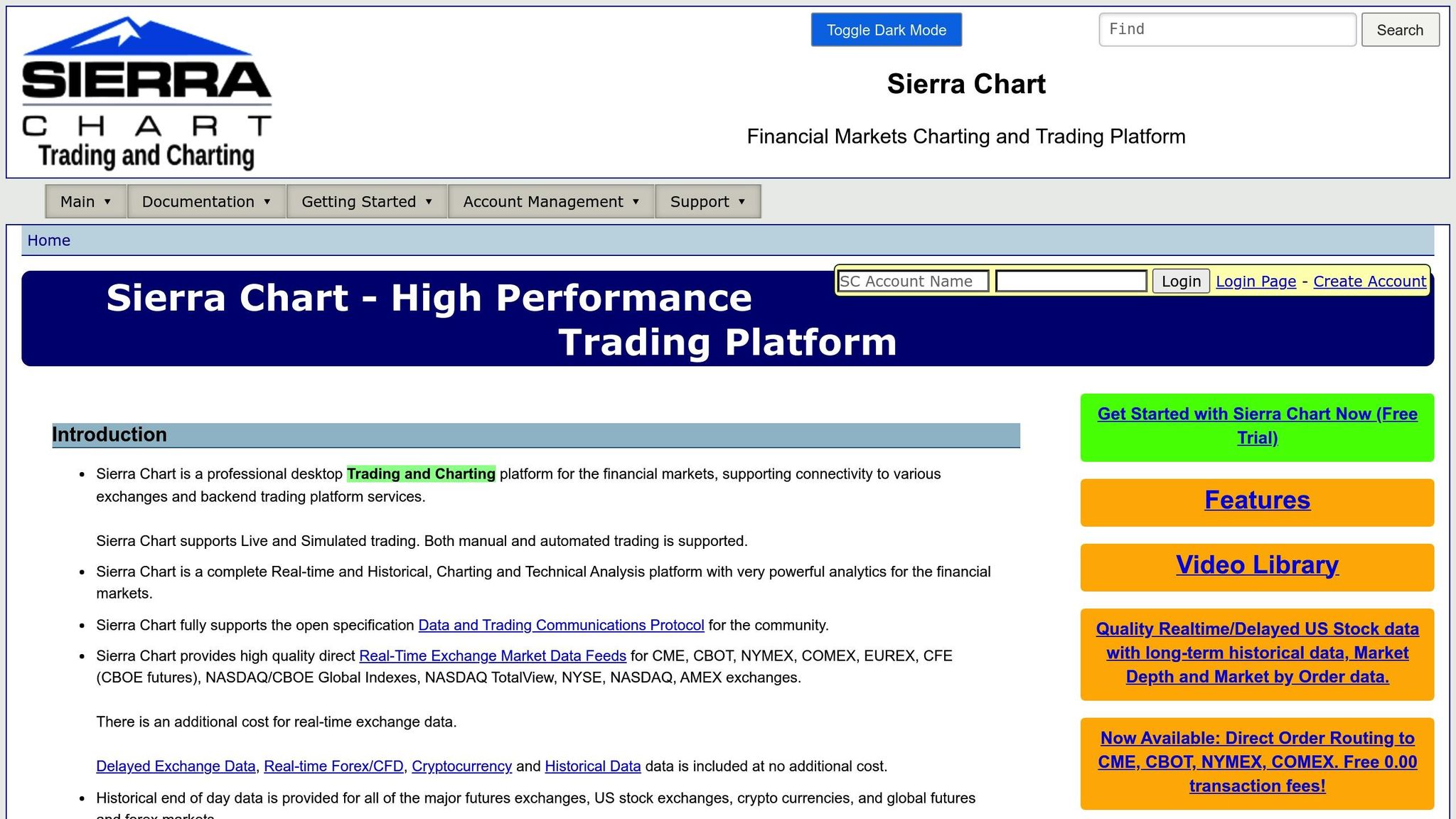
Sierra Chart has carved out a niche for itself in the trading world by offering a powerful platform for volume analysis and footprint charting. With its flexible and integrated design, it caters to traders looking for precise order flow visualization and advanced analytics.
Volume Analysis Features
At the heart of Sierra Chart’s capabilities is its advanced footprint charting, paired with a fully integrated chartdom (Depth of Market) feature. This chartdom provides real-time order book data directly within the interface, making it easier for traders to analyze volume dynamics. Additionally, the platform supports trading across major global exchanges, enabling detailed volume analysis for various asset classes.
Real-Time Order Flow Visualization
Sierra Chart’s chartdom functionality is the backbone of its real-time order flow visualization. By utilizing the Denali Exchange Data Feed, it delivers full market depth and market-by-order data. This level of detail gives traders valuable insights into liquidity patterns and order book behavior, which are essential for making timely decisions in fast-paced markets. Plus, its seamless integration supports a range of hardware setups, ensuring smooth operation during high-intensity trading sessions.
Hardware Compatibility
Sierra Chart is built to handle the demands of modern trading environments. It works with all 64-bit versions of Windows (7, 8, 10, 11, and Server) and even offers an ARM64 version for Apple M-series CPUs through emulation.
The platform’s performance relies heavily on CPU single-core speed, which is critical for running in single-instance mode. For traders using multiple instances, additional cores can help improve efficiency. To maximize performance, a dedicated solid-state drive (SSD) – ideally an NVMe SSD – is strongly recommended for faster chart loading and smoother operation.
In June 2025, a user named "blt" shared their experience running Sierra Chart on a high-end setup featuring an Intel I9-14900KS processor, 192GB DDR5 RAM, and a 2TB SSD. Their system powered eight 34-inch ASUS 2K monitors, with the CPU usage "barely if ever hitting 5%".
"A dedicated solid-state drive with just Sierra Chart installed to it is strongly recommended."
Graphics cards typically don’t limit performance unless OpenGL is enabled. Even mid-range professional GPUs are sufficient for multi-monitor configurations.
Supported Trading Platforms
Sierra Chart is compatible with a wide range of trading platforms and data services. It supports Windows, Mac, Linux, Cloud, On-Premises setups, and mobile devices like iPhones, iPads, Android devices, and Chromebooks. The platform works seamlessly with brokers using CQG, Rithmic, its proprietary Teton Futures Order Routing Service, and Interactive Brokers Trading Service. It also integrates with numerous cryptocurrency exchanges and trading platforms.
Pricing
Sierra Chart offers a free trial and a free version, allowing users to explore its features before committing. Detailed pricing information is available upon request. This flexibility makes it suitable for both individual traders and institutional users who need efficient tools for volume analysis.
sbb-itb-24dd98f
4. Jigsaw Trading
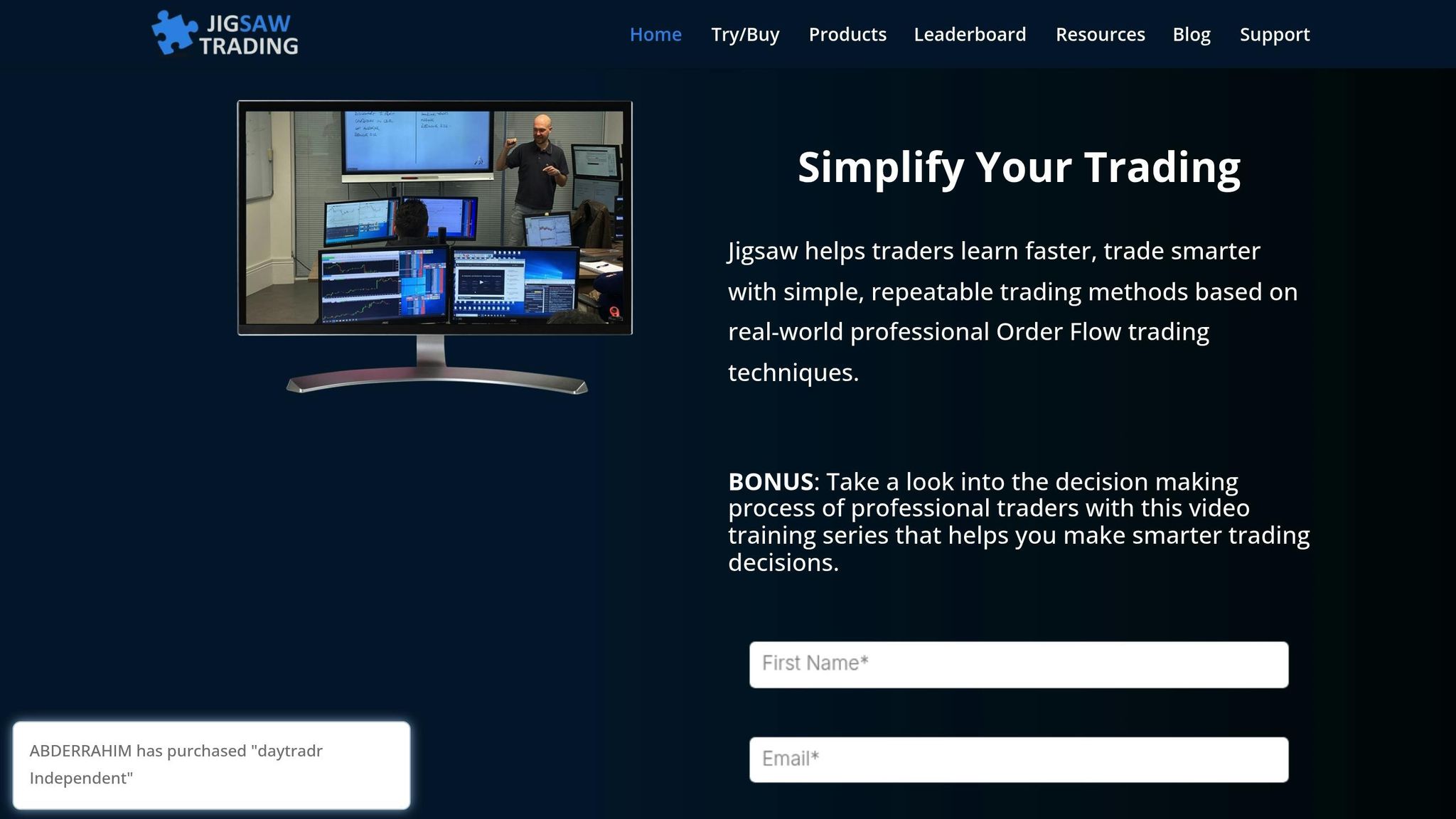
Jigsaw Trading is a well-regarded order flow platform used by professional traders. Founded in 2011 by Peter Davies, it has grown to serve over 3,500 customers worldwide. The platform has received accolades like "Trading Product of the Year" in the futures.io communities’ True Edge Awards and secured the top spot in the "Trading Software: Forex/Futures" category on Trader Planet.
Volume Analysis Features
Jigsaw Trading’s offerings revolve around its Journalytix analytics platform, which provides fast and dependable order flow data. The platform employs specialized trading techniques to highlight key market events, such as identifying trapped traders.
The Depth & Sales (DOM) tool delivers real-time insights into order interactions. It helps traders pinpoint areas where participants are stuck, tracks order pulling and stacking, and monitors trade momentum.
For a deeper dive into market depth, Auction Vista combines tools like Price Delta Charts and Cumulative Delta. This feature visualizes liquidity with shaded backgrounds and highlights high-volume zones with "Large Trade Circles", offering a clear view of real-time and historical order flow.
The Reconstructed Tape feature refines trade data by filtering orders by size, triggering block trade alerts, and differentiating buy and sell sides with color-coded visuals. Notably, Jigsaw re-bundles orders into their original executed sizes, which is particularly useful for backtesting strategies.
Real-Time Order Flow Visualization
The daytradr platform from Jigsaw Trading provides real-time order flow analysis with advanced visualization tools. It tracks buy and sell orders as they occur, offering instant clarity on market dynamics. Built for high-speed environments, the platform ensures responsiveness even in fast-paced markets through robust redundancy measures.
The Pace of Tape (PoT) Smart Gauge delivers a quick snapshot of trading activity compared to historical averages, helping traders spot shifts at critical points. Meanwhile, the Summary Tape displays both market sides, including quantities at the inside bid/offer and the Rolling Cumulative Delta.
To keep traders informed, Order Flow Event Alerts provide real-time audio and visual notifications for significant events such as iceberg orders, block trades, large trades, and divergence patterns. These tools enhance precision while optimizing hardware efficiency.
"Order flow trading can be effective as it helps a trader see real-time buying and selling pressure. It gives insight into what big players (like institutions) are doing, which helps in making faster and smarter trading decisions." – Marisha Bhatt, Financial Content Writer, TrueData
Hardware Compatibility
For traders seeking ultra-low latency, QuantVPS offers GPU VPS solutions tailored for Jigsaw Trading. With connectivity speeds of less than 0.52ms to CME, these setups leverage data centers strategically located in Chicago, close to major exchanges. This configuration ensures fast execution and minimizes slippage, making it ideal for high-frequency traders.
Supported Trading Platforms
Jigsaw Trading provides flexibility with two deployment options: the stand-alone daytradr platform and the Jigsaw Bridge/Plug-in, which integrates seamlessly with existing trading platforms.
The daytradr platform connects to major data feeds such as CQG Continuum, Rithmic, StoneX, Tradovate, Interactive Brokers, and IQFeed. It also supports GAIN broker data through platforms like Alpha Trader, Apex Trader, ATC Trader, CTG Pro, DT Pro, G-Force Trader, and Zaner 360.
The Jigsaw Bridge integrates with popular platforms like NinjaTrader 8, MetaTrader 5, MultiCharts.NET, and Tradovate. This option allows traders to incorporate Jigsaw’s tools into their existing setups without overhauling their workflows.
The platform supports trading in both futures and equities markets, including access to NASDAQ Level 2 data.
Pricing
Jigsaw Trading operates on a one-time payment model for its daytradr software, with three pricing tiers:
- Independent Plan: $579
- Professional Plan: $879
- Institutional Plan: $1,979
After purchasing the software, users need a live trading subscription priced at $50 per month or $500 annually to execute live trades through the Depth & Sales product. A 14-day money-back guarantee is also available.
Jigsaw offers both a free version and a free trial. The platform boasts a 5.0/5 overall rating and a 4.6 TrustScore (Excellent) on Trustpilot, based on 32 customer reviews.
"What sets Jigsaw apart is that we actively encourage our customers to communicate with each other. Indeed, we even provide a venue for them to meet in the ‘Jigsaw Chat Room,’ a friendly, un-moderated, live discussion room where traders discuss the market action." – Peter Davies, CEO, Jigsaw Trading
5. Quantower
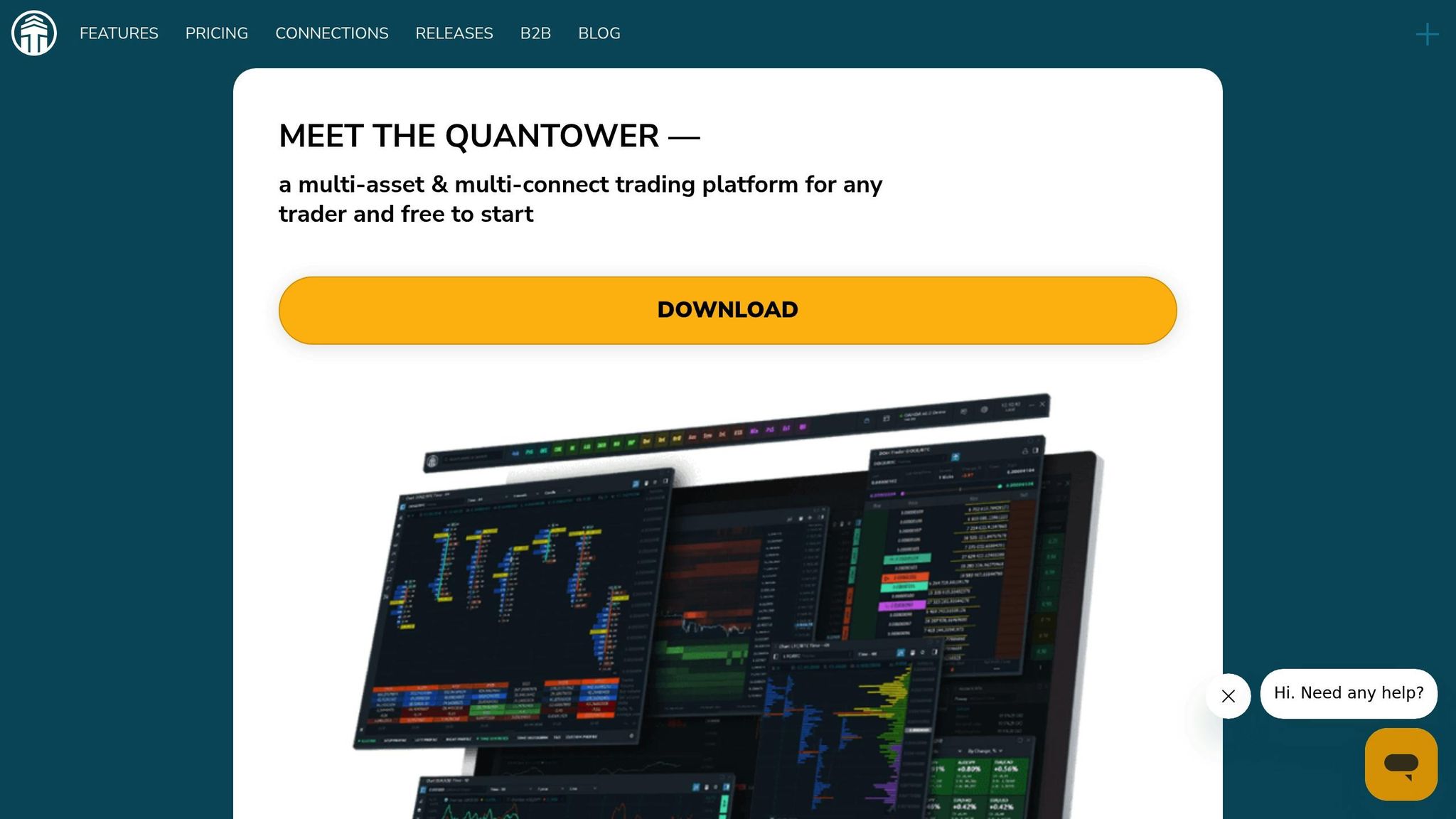
Quantower is a versatile trading platform designed for multi-asset trading, offering professional-grade volume analysis tools. With connections to over 60 brokers, cryptocurrency exchanges, and data providers, it has garnered high praise on Trustpilot for its stability and extensive features.
Volume Analysis Features
Quantower’s Cluster Chart (also known as Footprint or OrderFlow) combines price, volume, time, and order flow into a single, detailed chart. It supports various display modes – Single, Double, and Imbalance – using delta, volume, or trade-based coloring to highlight buyer and seller imbalances.
The Volume Profile tools provide a deep dive into trading activity, showing data for specific timeframes and price levels. Options include Step, Left, Right, and Custom Volume Profiles, all featuring key metrics like the Point of Control (POC) and a 70% Value Area.
For more granular insights, the Time Statistics & Histogram feature breaks down extended volume data for each bar. It supports over 20 data types, such as total volume, trade counts, buy and sell data, delta, filtered volume, and average or maximum trade size. Additionally, the DOM Surface visualizes market depth and liquidity changes using a heatmap, offering an intuitive view of limit orders at each price level.
Real-Time Order Flow Visualization
Quantower also excels in real-time order flow analysis. Its Historical Time & Sales tool provides a detailed view of executed trades, including volume, price, and order specifics for any historical bar. The TPO Profile Chart is another standout feature, analyzing price distribution during trading sessions to identify key support and resistance levels. It includes metrics like the TPO Point of Control, Value Area, and singles, with options for splitting or merging profiles for custom analysis periods.
The platform’s Volume Weighted Average Price (VWAP) functionality, including Anchored VWAP, helps traders evaluate price movements relative to volume-weighted averages, offering a clearer picture of market trends.
Hardware Compatibility
Quantower is compatible with Windows 10+ (64-bit) systems and requires Microsoft .NET Framework v4.8. For optimal performance, the platform recommends a system with at least 16 GB of RAM, a quad-core CPU, an SSD, and 1 GB of disk space. It supports multi-monitor setups, allowing users to create and save personalized workspaces across multiple screens. Its portable design also enables users to store and launch the platform from removable drives while keeping all settings intact. For traders engaged in high-frequency or automated trading, deploying Quantower on a Virtual Private Server (VPS) is recommended for low-latency and uninterrupted operation.
Supported Trading Platforms
Quantower connects seamlessly to a variety of markets, including cryptocurrencies, futures, stocks, options, and CFDs. It supports brokers like Interactive Brokers, TD Ameritrade, Alpaca, and Tradier for U.S. equities, ETFs, and options. In the crypto space, it integrates with platforms such as WOO Network (WOO X, WOOFi, WOO DEX), OKX, Binance, Kucoin, and Lynx. Additionally, it provides access to real-time, delayed, and historical market data through providers like DxFeed. For custom integrations, Quantower offers an Open C# API, making it a flexible choice for traders who require tailored solutions. Its multi-broker connectivity allows simultaneous connections, simplifying cross-platform analysis within a unified interface.
Pricing
Quantower offers both free and paid subscription options to cater to different trading needs:
- Crypto Package: Tailored for cryptocurrency traders, this plan costs $40 monthly, $108 quarterly, or $790 for a lifetime license. It includes advanced volume analysis tools.
- Multi-Asset Package: Priced at $50 monthly, $135 quarterly, or $990 for a lifetime license, this package provides access to all brokerage and data feed connections alongside advanced features.
- All-in-One Package: For full access to all features and future updates, this plan costs $70 monthly, $189 quarterly, or $1,290 for a lifetime license. It includes comprehensive volume analysis tools and all available connections.
The platform operates on a single-license model, meaning one paid license can only be used on a single computer at a time. Traders who need to run Quantower on multiple machines simultaneously must purchase additional licenses.
Comparison of Features and Pricing
When it comes to volume analysis tools in 2025, each platform brings distinct advantages to the table. TrendSpider shines with its Raindrop Charts, which combine price, volume, and sentiment into one innovative visualization. NinjaTrader, on the other hand, stands out for its robust order flow tools and free access to charting and simulation, making it a favorite for beginners.
For those seeking professional-grade customization, Sierra Chart offers a highly flexible, open-source interface paired with advanced trading depth of market features. Jigsaw Trading zeroes in on professional order flow techniques, providing real-time analytics to measure buy and sell order strength. Meanwhile, Quantower impresses with its multi-asset connectivity, integrating data from over 60 brokers and exchanges, along with flexible pricing options. This breakdown highlights key features and pricing to help you make an informed decision.
Pricing and Access Options
Pricing models vary widely across these platforms. NinjaTrader provides a budget-friendly entry point with free advanced charting and market analysis tools. Quantower offers a mix of free access and premium features, with subscriptions starting at $70 per month. TrendSpider targets the premium segment, with plans ranging from $89 to $199 per month. Both Sierra Chart and Jigsaw Trading offer pricing upon request, catering to users with specific needs.
| Platform | Volume Analysis Features | Real-Time Order Flow | Hardware Requirements | Supported Platforms | Pricing |
|---|---|---|---|---|---|
| TrendSpider | Raindrop Charts, volume alerts, support/resistance heatmaps | Multi-timeframe analysis, market updates | Windows, Mac, mobile apps | Multiple brokers/data feeds | $89 – $199/month |
| NinjaTrader | Order flow, volumetric bars, market depth analysis | Tick-by-tick scanning, live market data | Windows-optimized | Futures, forex, stocks | Free for charting |
| Sierra Chart | Trading depth of market (Chartdom) | Seamless live trading connectivity | High-performance systems | Multiple asset classes | Pricing on request |
| Jigsaw Trading | Order flow techniques, buy/sell strength analysis | Real-time analytics, event visualization | Professional setups | Multiple markets | Pricing on request |
| Quantower | Volume tools for multi-asset and crypto markets | Unified broker data interface | Windows 10+ (64-bit), 16GB RAM | 60+ brokers/exchanges | Free – $70/month |
Hardware Considerations
Hardware compatibility is another important factor. Most platforms are optimized for Windows, with NinjaTrader being specifically Windows-native. To ensure smooth operation, a minimum of 32 GB RAM and a processor benchmark of at least 60,000 are recommended.
"The processor is the engine of your computer. It’s the motor. It’s where all the heavy lifting happens. It is running your trading platform and all of that real-time data, your market data."
Customization and Learning Curve
Customization options and ease of use vary across platforms. TrendSpider offers tools like a JavaScript code editor and AI-powered visual scripting, while NinjaTrader allows custom indicator creation with its C# framework. Sierra Chart provides extensive flexibility through its open-source design, and Quantower includes customizable panels and strategy optimization. For beginners, NinjaTrader’s free access is a great starting point, while advanced users may benefit from the premium tools offered by TrendSpider, Jigsaw Trading, and Sierra Chart.
Market Connectivity
Each platform has its strengths in market coverage. Quantower integrates data from over 60 brokers and exchanges, offering unmatched connectivity. TrendSpider delivers comprehensive market coverage, while NinjaTrader excels in futures and forex connectivity. These insights should help traders align platform capabilities with their specific strategies and hardware setups. Ultimately, the best choice depends on the markets and instruments you plan to trade.
Conclusion
Finding the right alternative to Bookmap is all about aligning your trading style with the platform that best suits your needs. For scalpers and futures traders who rely heavily on order flow, Jigsaw Trading offers professional-grade tools like Auction Vista, tailored specifically for CME and other futures exchanges. If you’re just starting out or testing strategies, NinjaTrader provides free advanced charting and order flow analysis, making it a great choice without requiring upfront investment.
For swing traders and technical analysts, TrendSpider shines with its AI-powered trendline detection, Raindrop Charts, and smart alerts, which simplify complex workflows. With pricing ranging from $89 to $199 per month, it’s a solid option for those prioritizing automation. On the other hand, Sierra Chart is perfect for traders who value deep customization, while Quantower stands out with its ability to connect to over 60 brokers and exchanges, making it ideal for multi-asset traders.
But software alone isn’t enough – your hardware plays a key role in maximizing these tools. To handle real-time market data and ensure smooth performance across multiple platforms, aim for a processor with a benchmark score of at least 60,000 and 32 GB of RAM (64 GB is even better). Graphics cards are increasingly important, especially for local AI processing, which can speed up calculations and enhance data privacy. An NVIDIA RTX 4060 or better provides the tensor cores necessary for these tasks, giving you both speed and security advantages.
"The machine you use matters! Speed, stability, and multitasking power can make or break your trading day." – EZ Trading Computers
For traders serious about volume analysis, combining professional-grade software with high-performance hardware creates a distinct edge. Whether you opt for the automation capabilities of TrendSpider, the order flow tools of Jigsaw Trading, or the versatility of NinjaTrader, pairing the right platform with robust hardware ensures your system keeps up with fast-moving markets.
This combination of smart software and optimized hardware leads to faster execution, reliable data processing, and seamless multitasking. In the competitive trading landscape of 2025, having a well-balanced setup could be the difference between seizing profitable opportunities and missing out due to technical limitations.
FAQs
What sets TrendSpider and NinjaTrader apart for volume analysis?
TrendSpider is all about AI-powered tools designed to make life easier for traders. With features like automated chart pattern recognition and backtesting, it’s a go-to option for those who focus on technical analysis and refining their strategies. Its automation capabilities are a real time-saver, helping traders cut through the noise and focus on decision-making.
NinjaTrader, on the other hand, shines when it comes to in-depth volume analysis. Tools like market depth maps and volume profiles provide a closer look at market microstructure and order flow, giving traders a better understanding of what’s happening behind the scenes. The key difference? TrendSpider leans heavily on automation and AI, while NinjaTrader zeroes in on detailed volume and order flow data for those who want advanced market insights.
How does my hardware setup affect the performance of volume analysis tools?
Your hardware setup plays a key role in how well volume analysis tools perform. It affects how quickly data is processed, how stable your system runs, and how efficiently it handles tasks. Components like a fast CPU, plenty of RAM, and high-bandwidth buses are critical for processing large datasets quickly and accurately. Without these, you might face slow performance – or even system crashes – at crucial trading moments.
On top of that, using high-performance storage like SSDs and reliable network components can reduce latency and prevent bottlenecks, allowing for real-time data analysis. Outdated or unreliable hardware can skew results and disrupt your trading workflow, so keeping your setup optimized is essential for smooth operations.
What is the best platform for multi-asset traders to connect with multiple brokers and exchanges?
For traders dealing with multiple asset classes, Quantower stands out as a solid choice. With support for over 60 connections to brokers, exchanges, and data feeds, it offers smooth integration while remaining neutral to any specific broker. This makes it a great fit for those who require flexibility and a unified platform to manage diverse trading strategies.
Similarly, TradeRevolution is another top contender, boasting more than 60 integrations with prime brokers, banks, ECNs, and exchanges. Its reliable connectivity is designed to handle multi-broker and multi-exchange setups, making it particularly appealing for professional traders managing intricate trading environments.

